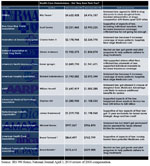The CEOs of many key health care trade groups earned big bonuses in 2009, when the congressional debate over health legislation dominated their agendas.
While the bonuses suggest that member companies were pleased with the performance of their Washington advocates, the battle over the law isn’t over, and the well-rewarded CEOs and lobbyists face new challenges. There’s ferment in some groups: PhRMA replaced departed CEO Billy Tauzin in 2010 with former Business Roundtable CEO John Castellani and five of the largest members of America’s Health Insurance Plans are considering creating a separate coalition from the trade group, even as they remain members of the organization.
Chart: CEO Pay 2008-2009
Overall, the chief executives were paid well: Nine of 12 health care trade associations paid their CEOs compensation of $1 million or more, including bonuses, deferred compensation and other benefits, according to tax records for 2009. (Tax-exempt groups must file annually with the IRS on a form 990, which is available to the public. The data typically lags a year.) Lobbyists at the associations received compensation in the range of $250,000 to more than $1 million.
“This was an industry that was facing a bet-the-farm debate, so that is why you see these executives get paid the big money,” said Ivan Adler, a principal at the head-hunting firm McCormick Group.
Chart: Lobbyist Pay 2009
Most of these compensation packages were approved by boards of the trade associations in 2008, before the big health care battle, and the pay levels for some executives were lower in 2009 than in 2008. It’s increasingly common that these packages include base pay, plus a bonus and deferred compensation as incentives to key association staff to meet financial, advocacy and other goals specific to associations.
“There is no one formula [for] association compensation,” said Nels Olson, managing director of at head hunting firm Korn/Ferry. “But one that is relevant here is advocacy, given the health care debate in Washington.”
Tauzin, the former CEO of PhRMA, is among those who received a bonus. On top of his base pay of $2.1 million, he was awarded a $2.3 million bonus. James Bryant Hall, PhRMA’s top federal lobbyist after Tauzin, received a bonus of $91,750 on top of his $371,182 base pay. Another key health care player, Scott Serota, CEO of Blue Cross and Blue Shield Association, earned a bonus of $1.6 million on a base salary of $856,055, and BCBSA chief lobbyist Alissa Fox received a $130,000 bonus plus base pay of $278,760. Chip Kahn, CEO of the Federation of American Hospitals, received a base salary of $900,000 and a bonus of $315,000, while Jeff Cohen, one of the group’s top lobbyists, earned $325,000 in base pay and a bonus of $65,000.
PhRMA was among the advocacy winners when the law passed in 2010. The group agreed to discount the costs of brand-name prescription drugs for seniors hit by the “doughnut hole,” a compromise estimated to cost the industry about $80 billion. In turn, the industry received concessions from the White House that included a promise that the bill would not permit the reimportation of cheaper drugs from Canada. Hospitals were also winners. Even though they face cuts in Medicare reimbursements, the expansion of insurance coverage will reduce the number of uninsured seeking care in coming years.
Health insurers had a mixed record. They successfully beat back an effort to include a public health insurance option and stand to get millions of new customers from the requirement that nearly all Americans buy insurance. But the sector was demonized by the Democrats and the White House, and insurers fear the mandate isn’t strong enough to entice healthy people to buy insurance.
Now the groups’ leaders must wrestle with Republican vows to kill or change legislation, and the legal threat to the constitutionality of a critical provision requiring most Americans to carry insurance.
“Did they earn their pay?” said Adler of McCormick Group. “I think the question is still open because we don’t know what Congress and the courts are going to do next.”
To be fair to the executives and lobbyists in the accompanying graphic, there are some important caveats. They didn’t get all of that money in their paychecks. Deferred compensation programs are financial incentive packages that vest over time, but still must be reported to the IRS on an annual basis. For example, former AARP chief executive Bill Novelli’s 2009 compensation included a base salary of $345,243; a $1.2 million payment that included deferred compensation from his 8-year tenure at AARP and severance of $350,657; $35,362 in retirement and deferred compensation and $4,209 in nontaxable benefits. Novelli left AARP in April 2009 and was replaced by A. Barry Rand, whose total compensation was $648,640.
An association can decide to rescind compensation. In 2006, Craig Fuller, the former CEO of the National Association of Chain Drug Stores, left the organization when it became clear he and the organization’s board wanted to pursue different strategies. He left before his deferred-compensation plan vested. As a result, $1.12 million that had been set aside for him was returned to the association.








